Documents: Go to download!
- Owner's manual - (English)
- Getting to Know Your TV
- Connecting Your Devices
- WALL-MOUNTING THE TV
- USING THE REMOTE
- Completing The First-Time Setup
- Using the On-Screen Menu
- SETTING TIMERS
- SETTING UP CHANNELS
- USING PARENTAL CONTROLS
- USING THE RESET & ADMIN MENU
- SmartCast TV
- HELP TOPICS
Table of contents
VIZIO USER MANUAL
Models: D24h-G9, D40f-G9, D50x-G9 & V505-G9
TELEVISION ANTENNA CONNECTION PROTECTION
Ifan outside antenna/satellite dish or cable system is to be connected to the TV. make sure that the antenna or cable system is electrically grounded to provide some protection against voltage surges and static charges.
Article 810 of the National Electrical Code. ANSI/NFPSA 70. provides information with regard to proper grounding of the mast and supporting structure. grounding of the lead-in wire to an antenna discharge unit. size of the grounding conductors. location of antenna discharge unit. connection to grounding electrodes. and requirements of the grounding electrode.
Lightning Protection
For added protection of the TV during a lightning starm or when itis left unattended or unused for long periods of time. unplug the TV from the wall outlet and disconnect the antenna or cable system.
Power Lines
Do not locate the antenna near overhead light or power circuits. or where it could fall into such power lines or circuits. Remember. the screen of the coaxial cables intended to be connected to earth in the building installation.

Getting to Know Your TV
Remote Sensor and Power Indicator
When using the remote. aim it directly at this sensor. The power indicator flashes on when the TV turns on. then goes out after several seconds.
To keep the power indicator on as long as the TV is on. see Turning the Power Indicator On or Off

Rear Panel D24h-G9
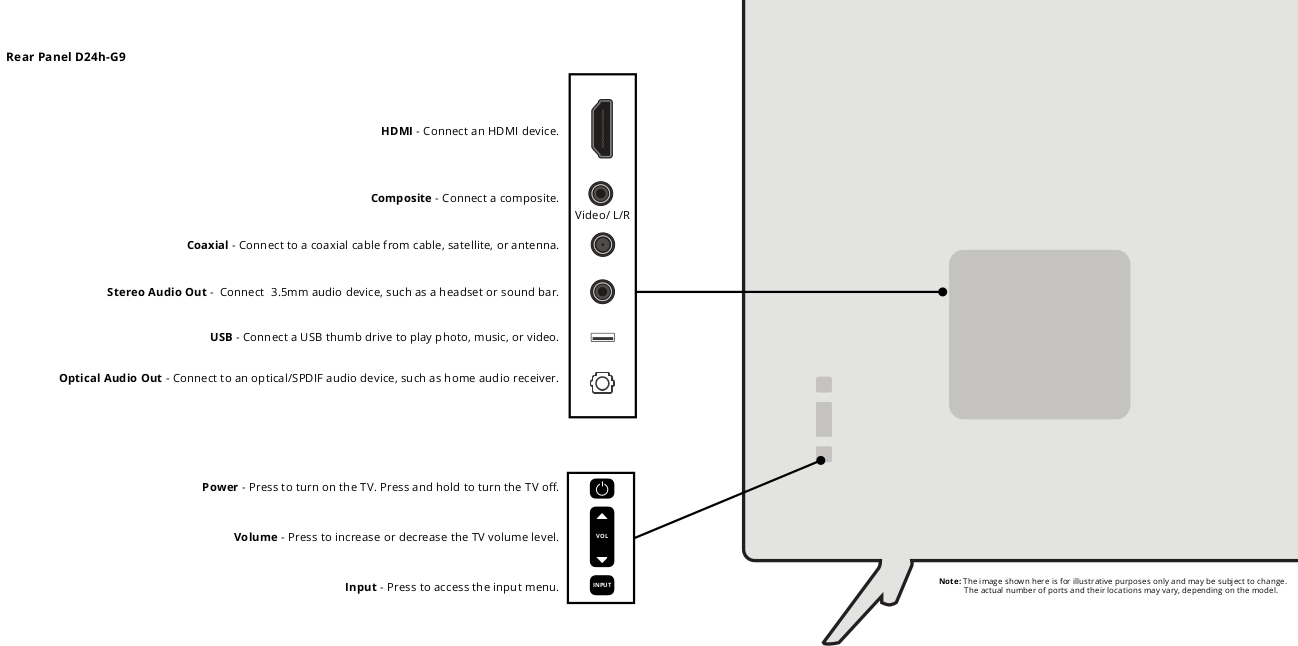
Note: The image shown here is for illustrative purposes only and may be subject to change. The actual number of ports and their locations may vary, depending on the model.
Rear Panel D40f-G9

Note: The image shown here is for illustrative purposes only and may be subject to change. The actual number of ports and their locations may vary, depending on the model.
REAR PANEL - D50x-G9 & V505-G9

Note: The image shown here is for illustrative purposes only and may be subject to change. The actual number of ports and their locations may vary, depending on the model.
Connecting Your Devices
AUDIO & VIDEO CABLE TYPES
Your TV can be used to display output from most devices.
1. Verify that your device has a video port that matches an available port on the TV (HDMI. Component. etc)
2. Connect the appropriate cable (not included) to the TV and the device.
3. Tum the TV and your device on. Set the TV's input to match the connection you used (HDMI-1. HDML-2. etc)
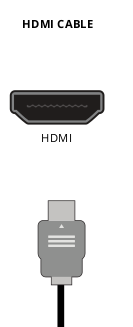
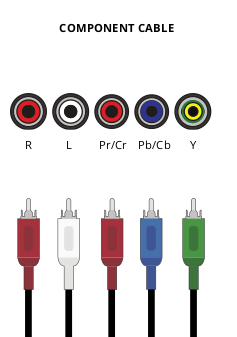

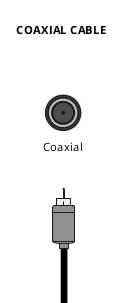
Note: The actual ports and their locations may vary, depending on the TV model.
CONNECTING A DEVICE - D24h-G9 ONLY
D24h-G9 includes a Composite In / AV In port that requires additional adapters (not included).
1. Connect the appropriate cable (not included) to the TV and the device using an adapter (not included).
2. Turn the TV and your device on. Set the TV's input to match the connection you used (Composite).


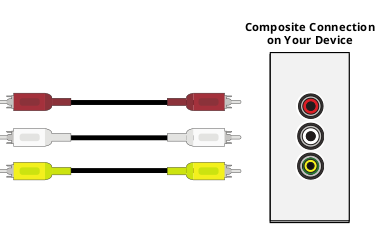
*The actual ports and their locations may vary, depending on the TV model.
CONNECTING A DEVICE - AUDIO CABLE TYPES
Your TV can be output sound to an audio device. such as a receiver or sound bar.
See other models: P75-F1 PQ65-F1 M657-G0 M70-F3 D32hn-E0
1. Verify that your device has audio port that matches an available port on the TV (Optical. RCA. etc).
2. Connect the appropriate cable (not included) to the TV and the device.
3. Tum the TV and your device on.

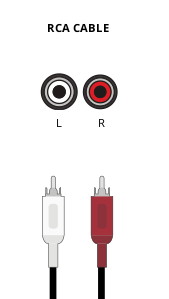

Note: The actual ports and their locations may vary, depending on the TV model.
WALL-MOUNTING THE TV
To mount your TV on a wall. you will need a wall mount. Consult the information on this page to find the appropriate mount for your TV.
Be sure the mount you choose is capable of supporting the weight of the TV. After you have determined that you have the correct mount for your TV. you can begin the installation.
To install your TV on a wall:
1. Disconnect any cables connected to your TV.
2. Place the TV face-down on a clean. flat. stable surface. Be sure the surface is clear of debris that can scratch or damage the TV.
3. If attached. remove the stands by loosening and removing the screws.
4. Attach your TV and wall mount to the wall. carefully following the instructions that came with your mount. Use only with a UL-listed wall mount bracket rated for the weight/load of this TV.
Installing a TV on a wall requires lifting. To prevent injury or damage to the TV. ask someone to help you.
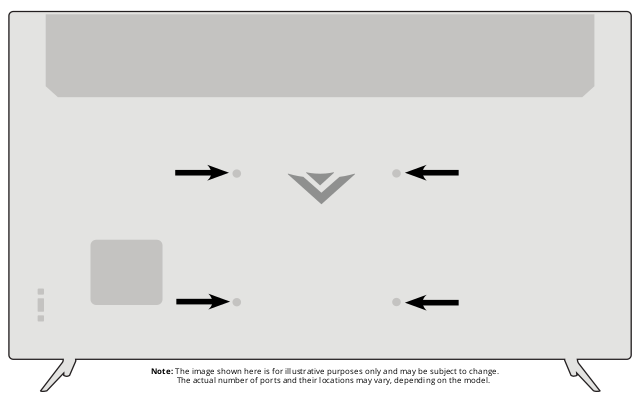
Note: The image shown here is for illustrative purposes only and may be subject to change. The actual number of ports and their locations may vary, depending on the model.

USING THE REMOTE

- Input - Change the currently displayed input
- Power - Turn Television on or off
- App Launcher - Quickly launch the pictured app
- Exit - Close the on-screen menu
- Menu - Display the settings menu
- Arrow - Navigate the on-screen menus
- OK/Play/Pause - Select the highlighted menu option and play or pause content
- Back - Go to the previous on-screen menu.
- Info - Display the info window
- Volume Up/Down - Increase or decrease the loudness of the audio
- Closed Caption - Open the closed caption menu
- V Button - Launch SmartCast TV/Return to SmartCast TV Home Screen
- Pic - Cycle through the different picture setting modes.
- Channel Up/Down: Change the channel
- Mute - Turn the audio on or off
- Last - Return to the channel last viewed
- Number Pad - Manually enter a channel
- Wide - Change the Television mode
- Dash - Use with number pad to manually enter a digital sub-channel. (For example. 18-4 or 18:5)
Replacing the Batteries
1. Find the notch on the back of the remote. Insert a coin and pry open the back cover.
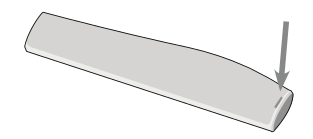
2. Insert two batteries into the remote control. Make sure that the (+) and (») symbols on the batteries match the (+) and (-) symbols inside the battery compartment.
3. Replace the battery cover.
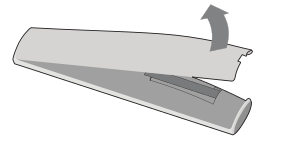
WARNING: keep the remote control batteries away from children. It may cause choking and/or lead toa fire or chemical burn if mishandled. Do not dispose of batteries infire. Replace only with batteries of the correct type.
When needed. VIZIO recommends replacing the batteries that came with this remote with two. new Duracell AAA’ alkaline batteries
Completing The First-Time Setup
The first time you turn on the TV. the on-screen instructions will guide you through each of the steps necessary to get your TV ready for use:
Before you begin the first-time setup:
Your TV should be installed and the power cord should be connected to an electrical outlet.
If you have a wireless network. have the network password ready.
If you are connecting to your network with an Ethernet cable. connect itto the Ethernet port on the TV.
1. Choose your language.

2. Choose home use.
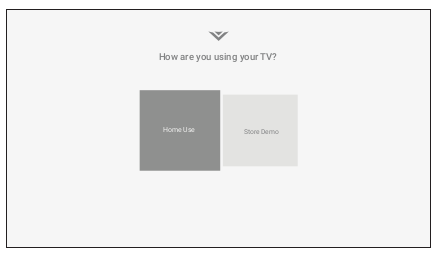
3. Choose your country.
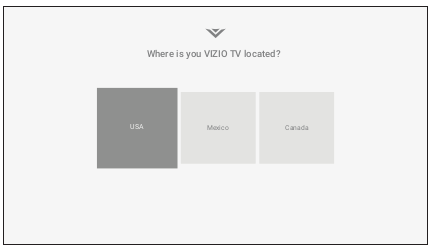
4. Choose your Wi-Fi and enter the password.
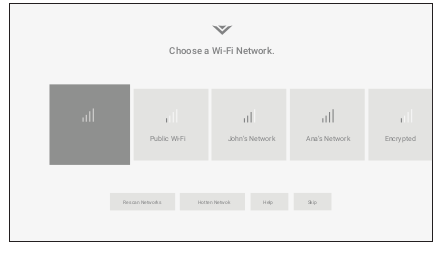
5. Name your TV.

6 Scan for channels.
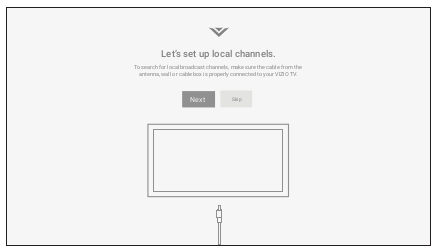
7. Accept the T&Cs and register your device.

All set!

Using the On-Screen Menu
Your TV features an easy-to-use on-screen menu.
To open the on-screen menu. press the Menu button on the remote.
From this menu. you can:
- Adjust the Picture settings
- Adjust the Audio settings
- Adjust the Network settings
- Set up the Timers
- Adjust the Channel settings
- Set up Closed Captioning
- Name and adjust Inputs
- Adjust TV settings
- View user manual
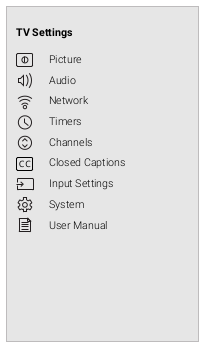
NAVIGATING THE ON-SCREEN MENU
To open the on-screen menu:
1. Press the Menu button on the remote.
2. Use the Arrow buttons to highlight a menu option. and press the OK button to select that option.
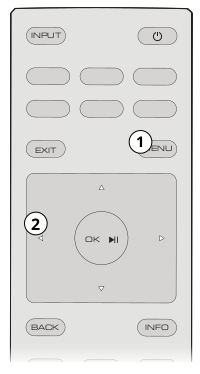
While navigating the on-screen menu. you can press the Back button at any time to return to the previous menu screen. The Exit button will close the on-screen menu.
CHANGING THE INPUT SOURCE
External devices such as DVD players. Blu-ray Players. and video game consoles can be connected to your TV. To use one of these devices with your TV. you must first change the input source using the Input menu.
To change the input sources:
1. Press the Input button on the remote. The Input menu is displayed.
2. Use the Right/Left Arrow buttons or the Input button on the remote to highlight the input you wish to view and press OK. The selected input is displayed.
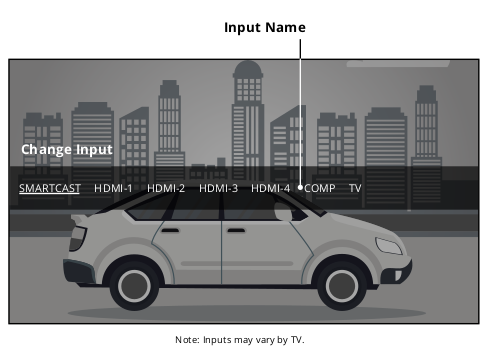
You can change the input names that appear on the input menu to make your devices easy to recognize. See Renaming Devices on the Input Menu for more information.
CHANGING THE SCREEN ASPECT RATIO
The TV can display images in four different modes: Normal. Panoramic.
Wide. and Zoom. Each mode displays the picture differently.
Some programs have black bars on the top or sides of the picture so that the picture keeps its original shape. Examples include wide-screen movies and older television programs.
To change the screen aspect ratio:
1. Press the Wide button on the remote.
2. Use the Arrow buttons to highlight the aspect ratio you wish to view and press OK.
+ Normal preserves the content's original aspect ratio and size.
+ Stretch expands a widescreen image to fill the screen from top to bottom and stretches it half as much from right to left. Figures appear tall and thin.
+ Wide stretches a 4:3 aspect ratio picture to the edges of the screen. Since the picture is being stretched. the display image may appear distorted—figures appear short and fat. If the program is already formatted for widescreen viewing (1.85:1 or 2.35:1). then black bars will appear on the top and bottom of the display image.
+ Zoom expands images evenly in all directions (33% taller and 33% wider) with black bars to fit the screen. A 720p image will fill a 1080p screen.
Tip: The aspect ratio cannot be changed for Ultra HD content or HDR content.
Note: Aspect ratio setings may vary by Input source.

ADJUSTING THE PICTURE SETTINGS
Your TV can be adjusted to suit your preferences and viewing conditions.
Ifyou save changes to the settings for a picture mode. an asterisk appears after its name (see Saving a Custom Picture Mode).
To adjust the picture settings:
1. Press the Menu button on the remote. The on-screen menu is displayed.
2. Use the Arrow buttons on the remote to highlight Picture and press OK. The Picture menu is displayed.
3. Use the Arrow buttons on the remote to highlight Picture Mode. then use the Left/Right Arrow buttons to change the picture mode:
+ Standard mode sets the picture settings to the default settings.
+ Calibrated mode sets the picture settings to values ideal for watching TV in a brightly-lit room.
+ Calibrated Dark mode sets the picture settings to values ideal for watching TV in a dark room. id mode sets the picture settings to values that produce a brighter. more vivid picture.
+ Game mode reduces throughput delays and optimizes the picture settings for displaying game console output.
+ Computer mode optimizes the picture settings for displaying computer output.
4. To manually change each of the picture settings. use the Up/ Down Arrow buttons on the remote to highlight that picture setting. then use the Left/Right Arrow buttons to adjust the setting:
- Backlight - Adjusts the LED brightness to affect the overall brilliance of the picture. Backlight cannot be adjusted when starting from some picture modes.
- Brightness - Adjusts the black level of the picture. When this setting is too low. the picture may be too dark to distinguish details.
- When this setting is too high. the picture may appear faded or washed out.
- Contrast - Adjusts the white level of the picture. When this setting is too low. the picture may appear dark. When this setting is too high. the picture may appear faded or washed out. If the setting is too high or too low. detail may be difficult to distinguish in dark or bright areas of the picture.
- Color - Adjusts the intensity of the picture colors.
- Tint - Adjusts the hue of the picture. This setting is useful in adjusting the flesh tones in the picture. If flesh appears too orange. reduce the level of color before adjusting tint.
- Sharpness - Adjusts the edge sharpness of picture elements. Itcan be used to sharpen non-HD (high definition) content; however. it will not produce detail that does not otherwise exist.
When you have finished adjusting the picture settings, press the Exit
button on the remote.
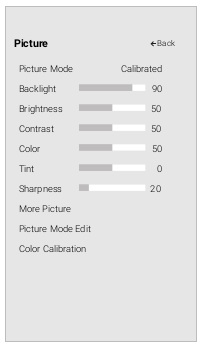
Adjusting More Picture Set!
To adjust more picture settings:
1. From the PICTURE menu. use the Arrow buttons to highlight More Picture. and then press OK.
2. Use the Arrow buttons to highlight the setting you wish to adjust. then press the Left/Right Arrow buttons to change the setting:
+ Color Temperature - See Adjusting the Color Temperature.
+ Black Detail - Adjusts the average brightness of the picture to compensate for large areas of brightness. Select Off. Low. Medium. or High.”
+ Reduce Noise Reduce Signal Noise Diminishes artifacts in the image caused by the digitizing of image motion content. Select Off. Low. Medium. or High. Reduce Block Noise - Reduces pixelation and distortion for mpeg files. Select Off. Low. Medium. or High.
Game Low Latency - Select On to reduce video delay (lag) when gaming.
Film Mode - Optimizes the picture for watching film. Select Auto or Off.”
Gamma - Set the shape of the Gamma curve. Use lower Gamma values for bright room conditions. and higher values when it’s dark.
When you have finished adjusting More Picture Settings. press the Exit button on the remote.
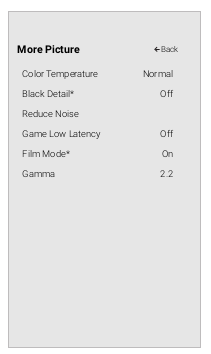
Adjusting the Color Temperature
Adjusting the color temperature changes the white balance of the picture.
To adjust the color temperature:
1. From the MORE PICTURE menu. use the Arrow buttons to highlight Color Temperature. and then press OK.
2. Use the Arrow buttons on the remote to highlight a color temperature preset and then press oK.
+ Normal is optimized for television viewing.
+ Cool produces a blue-hued picture.
+ Computer optimizes the picture for use as a PC monitor.
3. When you have finished adjusting the color temperature. press the Exit button on the remote.

Adjusting the Picture Mode Edit Settings
Picture Mode Edit Settings allow you to make precise adjustments to the picture and to create picture modes to save groups of picture settings.
To adjust the Picture Mode Edit settings:
From the PICTURE menu. use the Arrow buttons to highlight Picture Mode Edit. and then press OK.
The PICTURE MODE EDIT menu is displayed.
Use the Arrow buttons to highlight the setting you wish to adjust. then press OK to change the setting:
Save Picture Mode - Save a custom picture mode.
Lock Picture Mode - Prevent changes to custom picture modes. Choose between On or Off.
Reset Picture Mode' - Reset the picture mode settings to factory default values.

Saving a Custom Picture Mode
Custom picture modes allow you to save a group of custom settings for various viewing conditions and video sources.
+ Changes made while on any preset picture mode will add an asterisk on the top right corner of the preset mode.
+ The custom picture mode is not automatically saved.
To save a custom picture mode:
1. From the PICTURE MODE EDIT menu. use the Arrow buttons to highlight Save Picture Mode. and then press OK. The SAVE PICTURE MODE menu is displayed.
2. Use either on-screen keyboard to enter a name for your custom picture mode.
3. Highlight Save and press OK.
Press the Exit button to exit the menu screens.

Locking/Unlocking a Custom Picture Mode
Custom picture modes can be locked/unlocked with a unique PIN to prevent accidental changes to their settings.
To lock all custom picture modes:
1. From the PICTURE MODE EDIT menu. use the Arrow buttons to highlight Lock Picture Mode. and then press OK. The LOCK PICTURE MODE menu is displayed.
2. Use the Number Pad on your remote to enter a unique 4-digit PIN. If a system PIN is set. then lock/unlock. If no system PIN is set. then you will be prompted to set a PIN.
3. Highlight Save and press OK. Press the Exit button to exit the menu screens.
To unlock all custom picture modes:
1. From the PICTURE MODE EDIT menu. use the Arrow buttons to highlight Lock Picture Mode. or wen and then press OK. The LOCK PICTURE MODE menu is displayed.
Use the Arrow buttons to select Off.
Use the Number Pad on your remote to enter your 4-digit PIN. Make any desired changes to the picture modes.
Then turn ON Lock Picture Mode.
Press the Exit button to exit the menu screens.
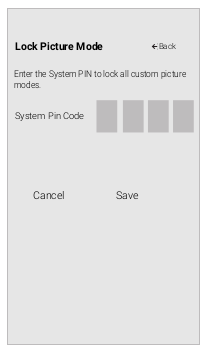
Deleting a Custom Picture Mode
Custom picture modes that are no longer needed can be deleted.
Inputs assigned to a deleted custom picture mode become (> assigned to the Calibrated picture mode.
To delete a custom picture mode:
1. From the PICTURE MODE EDIT menu. use the Arrow buttons to highlight Delete Picture Mode. and then press OK. The DELETE PICTURE
MODE window is displayed.
2. Use the Left/Right Arrow buttons to highlight Delete and press OK.
3. Press the Exit button to exit the menu screens.

Resetting a Picture Mode
A preset picture mode that has been edited can be restored to the factory default settings.
To reset a customized preset picture mode:
1. From the PICTURE MODE EDIT menu. use the Arrow buttons to highlight Reset Picture Mode. and then press OK. The RESET PICTURE MODE window is displayed.
2. Use the Left/Right Arrow buttons to highlight Reset and press OK.
3. Press the Exit button to exit the menu screens.

Adjusting the Color Tuner Settings
The Color Tuner settings allow you to adjust the HSB color and 11 point white balance. turn color channels off for testing. and display color bar. flat. and ramp test patterns.
The Color Tuner. 11 Point White Balance. and test patterns allow technicians to manually calibrate the TV. Calibration requires specialized training. an input with precisely set colors. and a specialized light meter.
To adjust the HSB color settings:
1. From the COLOR CALIBRATION menu. use the Arrow buttons to highlight Color Tuner. and then press OK. The Color Tuner menu is displayed.

2. Use the Arrow buttons on the remote to highlight the Hue.
Saturation. Brightness. Offset. or Gain of the color you wish to. adjust. Press the OK button.
3. Use the Left/Right Arrow buttons to adjust the value. When you are finished press the OK button to save the setting.
4. When you have finished adjusting the color tuner settings. press the Exit button.
To turn color channels off and on:
1. From the COLOR CALIBRATION menu. use the Arrow buttons to highlight Color Tuner. and then press OK. The COLOR TUNER menu is displayed.

2. Use the Arrow buttons on the remote to highlight Red. Green. or Blue.
3. Press the OK button to turn the color channel off or on. An X appears over a color channel that has been turned off.
4. Use the Arrow buttons to highlight another color channel to turn off or on. Only two color channels can be turned off at the same time.
5. When you have finished with the color channels. press the Exit button.
To adjust the 11 Point White Balance settings:
1. From the Color Tuner menu. use the Arrow buttons to highlight Color Tuner. and then press the Left/Right Arrow buttons until the 11 POINT WHITE BALANCE menu is displayed.

2. Use the Arrow buttons on the remote to highlight the Gain and Color values you wish to adjust. Press the OK button and use the Left/Right Arrow buttons to adjust the value. When you are finished. press the OK button to save the setting.
3. When you have finished. press the Exit button.
To show or hide the SMPTE Test Pattern:
1. From the Color Tuner menu. use the Arrow buttons to highlight Calibration Tests. and then press the Left/Right Arrow buttons until the SMPTE TEST PATTERN menu is displayed.

2. Use the Arrow buttons on the remote to highlight Off. Use the Left/Right Arrow buttons to highlight On to show the SMPTE Pattern. —or—
To hide the SMPTE Test Pattern. use the Left/Right Arrow buttons to highlight Off.
3. When you are finished. press the Exit button.
To show or hide the Flat Test Pattern:
1. From the Color Tuner menu. use the Arrow buttons to highlight Calibration Tests. and then press the Left/Right Arrow buttons until the FLAT TEST PATTERN menu is displayed.

2. Use the Arrow buttons on the remote to highlight Off. Use the Left/Right Arrow buttons to select the percentage brightness for the flat test pattern. Selecting a percentage immediately shows the flat pattern at that brightness. —or—
To disable the Flat Test Pattern. use the Left/Right Arrow buttons to highlight Off.
3. When you are finished. press the Exit button.
To show or hide the Ramp Test Pattern:
1. From the Color Tuner menu. use the Arrow buttons to highlight Calibration Tests. and then press the Left/Right Arrow buttons until the RAMP TEST PATTERN menu is displayed.

2. Use the Arrow buttons on the remote to highlight Off. Use the Left/Right Arrow buttons to select the color for the ramp test pattern. Selecting a color immediately shows that color ramp. —or—
To hide the Ramp Test Pattern. use the Left/Right Arrow buttons to highlight Off.
3. When you are finished. press the Exit button.
To show or hide the Uniformity Analyzer Test Pattern:
1. From the Color Tuner menu. use the Arrow buttons to highlight Calibration Test. and then press the Left/Right Arrow buttons until the UNIFORMITY ANALYZER TEST PATTERN menu is displayed.

2. Use the Arrow buttons on the remote to highlight Off. Use the Left/Right Arrow buttons to highlight On to show the Uniformity Analyzer Test Pattern. —or—
To hide the Uniformity Analyzer Test Pattern. use the Left/Right Arrow buttons to highlight Off.
3. When you are finished. press the Exit button.
ADJUSTING THE AUDIO SETTINGS
To adjust the audio settings:
1. Press the Menu button on the remote. The on-screen menu is displayed.
2. Use the Arrow buttons on the remote to highlight Audio and press OK. The Audio menu is displayed.
3. Use the Arrow buttons to highlight the setting you wish to adjust. then press Left/Right
Arrow buttons to change the setting:
+ Speakers - Turns the built-in speakers On or Off.
+ Volume Control Display - Toggle between On or Off to hide or display the on-screen volume slider that appears when volume is adjusted.
Surround Sound - Surround sound uses DTS TruSurround to deliver an immersive surround sound experience from the TV's internal speakers. TruSurround completes the entertainment experience by providing deep. rich bass and by delivering crisp details and clear. intelligible dialog. Select On or Off.
Volume Leveling - Volume leveling uses DTS TruVolume to maintain consistent volume levels during transitions between program content. AV formats. and input sources. Select On or Off In a few cases. volume leveling may artificially suppress volume increases. making it difficult to hear dialog or flattening sudden noises. If this occurs. turn volume leveling off.
When the TV speakers are set to On. DTS signals cannot be passed through digital audio outputs.
+ Balance - Adjusts the loudness of the audio output from the left and right speakers.
+ Lip Syne - Adjusts the synchronization between the display image and the accompanying audio track. igital Audio Out - Changes the type of processing for digital audio out and HDMI ARC output when connected to a home theater audio system. Select Auto. PCM. Dolby D or Bitstream.
You must select Bitstream for audio with more than two channels (3.0. 5.0. or 5.1. for example).
+ Analog Audio Out - Sets the volume control properties for the RCA connector when connected to a home theater audio system.
Select Variable if you are controlling the volume with the TV's volume controls. or select Fixed if an external audio device (sound bar or AV receiver) will control the volume.
4. When you have finished adjusting the audio settings. press the Exit button on the remote.
ADJUSTING THE NETWORK SETTINGS
Your TV is internet-ready. featuring both an Ethernet port and built-in high-speed Wireless-N. D24h-G9 and D40F-G9 support Wireless-N. D50x-G9 and V505-G9 support Wireless-AC.
If your TV is connected to a network with an Ethernet cable. you will not see the wireless netwark connection menu. You (J) must unplug the Ethernet cable to set a wireless network connection
Connecting to a Wireless Network
To connect to awireless network whose network name (SSID) is being broadcast:
Press the Menu button on the remote. The on-screen menu is displayed.
Use the Arrow buttons on the remate to highlight Network and press OK. The NETWORK menu is displayed.
If you do nat see your wireless network displayed. highlight More Access Points and press OK. The WIRELESS ACCESS POINTS menu. which is a list of available wireless networks. is displayed.
Highlightthename of yourwireless network (this is the network's SSID) and press OK.
Using the on-screen keyboard. enter your networks password. then highlight Connect and press OK.
6. Press the Exit button on the remote.
Changing the Manual Setup Settings
Advanced users can fine-tune the network settings using the Manual Setup feature.
To change advanced network settings:
1. From the NETWORK menu. highlight Manual Setup and press OK. The MANUAL SETUP menu is displayed.
2. To change the settings manually. use the Arrow buttons an the remote to highlight DHCP and then use the Left/Right Arrow buttons to change the setting to Off.
3. Use the Arrow and OK buttons to adjust each setting:
+ IPAddress - The IP address assigned tothe TV.
+ Subnet Mask The subnet Exit 2D
+ Default Gateway - Your network's default gateway address
+ Pref. DNS Server - Your preferred domain name server address.
+ Alt. DNS Server Your alternate domain name server address.
4. Use the Arrow buttons on the remote to highlight Save and press OK.
5. Press the Exit button on the remote.
Finding MAC Addresses for Network Setup
The security settings on your router may require you to enter the TV's. MAC address in the router's settings. To find the TVs MAC address:
1. From the NETWORK menu. highlight Manual Setup and press OK. The MANUAL SETUP menu is displayed.
2. Find the MAC address for the TV at the bottom of the list. The MAC addresses for the connections in use are displayed:
+ RJ4S MAC. The Ethernet or RJ45 MAC address may beneeded to set up your network when yau have connected the TV to your network when you have connected the TV to your network with an Ethernet (Cat 5) cable.
+ Wireless MAC - The Wireless (WiFi) MAC address may be needed to connect your TV to your network with WiFi
Connecting to a Hidden Network
To connect to awireless network whose network name (SSID) is not being broadcast:
From the NETWORK menu. highlight Hidden Network and press OK. The ENTER ACCESS POINT NAME screen is displayed. Using the on-screen keyboard. enter your network's name (SSID). then highlight Connect and press ox.
Using the on-screen keyboard. enter your network's password. then highlight Connect and press ox.
Press the Exit button on the remote.
Testing Your Network Connection
To test your network connection:
1. From the NETWORK menu. highlight Test Connection and press oK.
2. The TEST CONNECTION screen displays the connection method. network name. signal strength. and download speed of your network connection.
3. Press the Exit button on the remote.
SETTING TIMERS
Setting the Timer
When activated. the TV's timer will turn the TV off after a set period of time.
Press the Menu button on the remote. The on-screen menu is displayed.
Use the Arrow buttons on the remote to highlight Timers and press OK. The TIMERS menu is. displayed.
Use the Left/Right Arrow buttons on the remote to highlight the period of time after which you want the TV to go to sleep: 30. 60. 90. 120. or 180 minutes. If you don’t want the sleep timer to activate. change the setting to Off.
When you have finished setting the sleep timer. press the Exit button on the remote.
Setting the Auto Power Off Feature
To help save energy. your TV is set by default to turn off after 10 minutes without a video or audio signal. This feature can be deactivated.
To set the Auto Power Off feature:
1. From the TIMERS menu. use the Up/Down Arrow buttons on the remote to highlight Auto Power Off.
2. Use the Left/Right Arrow buttons on the remote to change whether the TV will turn off. If you don’t want the TV to turn off when there is no signal. change the setting to Off. Otherwise. select 10 minutes.
3. When you have finished setting the auto power off time. press the Exit button on the remote.
Using the Blank Screen Feature
To help save LED life. your TV screen can turn on or off while audio is streaming. To use the Blank Screen feature:
1. From the TIMERS menu. use the Up/Down Arrow buttons on the remote to highlight Blank Screen.
2. Press the OK button to immediatly blank the screen.
3. To exit Blank Screen. press any key.
SETTING UP CHANNELS
You can use the TV's Channels menu to:
- Find Channels
- Select channels to skip
- Select Analog Audio mode
- Select the language for Digital Audio
- Set Parental Controls
Scanning for Channels
The TV may need to scan for channels before it can display programs and their associated information. A channel scan is required for free over-the-air channels (using an antenna) and cable channels from an out of-the-wall connection (without a cable box). Moving the TVto an area with different channels requires the TV to scan for channels again.
To perform an Auto Channel Scan:
1. From the CHANNELS menu. highlight Find Channels. and press OK. The auto channel scan begins.
2. Wait until the channel scan is 100% complete. Highlight Done and press OK.
3. Press the Exit button on the remote.
If the channel scan is canceled. the channels that were already discovered are retained. A new channel scan will clear all channels.
Skipping Channels
After a channel scan is completed. you may find that some channels are too weak to watch comfortably. There may also be some channels you do not want to view. You can remove these channels from the TV's memory with the Skip Channel feature.
Channels that have been removed with the Skip Channel feature can still be viewed if the channel is entered using the Number Pad. If you wish to completely block a channel from being viewed. use the parental controls. See Locking and Unlocking Channels.
To remove a channel:
From the CHANNELS menu. highlight Skip Channel. and press OK. The SKIP CHANNEL menu is displayed.
For each channel you wish to remove. use the Up/Down Arrow buttons on the remote to highlight the channel and press OK. A v appears to the right of each channel you select.
When you have selected all of the channels you wish to remove. press the Exit button on the remote.
LISTENING TO ALTERNATE AUDIO
Changing the Analog Audio Language Some analog over-the-air (free) and cable channels broadcast programs in more than one language. The TV's Analog Audio feature allows you to listen to audio in an alternate language using Secondary Audio Programming (SAP).
Not all programs are broadcast in SAP. The Analog Audio Language feature only works when the program being viewed is being broadcast with Secondary Audio Programming.
To use the Analog Audio feature:
1. From the Channels menu. highlight Analog Audio and press OK. The Analog Audio menu is displayed.
2. Select Stereo. SAP (secondary audio programming). or Mono. Press OK.
3. Press the remote. button on the
To use the Digital Language feature:
1. From the CHANNELS menu. highlight Digital Audio and press OK. The DIGITAL LANGUAGE menu is displayed.
2. Select your preferred language:
- Enolish. Snanish/Video
- Description. French. Press OK.
3. Press the Exit button on the remote.
USING PARENTAL CONTROLS
The TV's parental controls allow you to prevent the TV from displaying certain channels or programs without a password.
Other devices have their own parental control settings.
The PARENTAL CONTROLS menu only appears when:
+ You are using the tuner to receive your TV signals. such as when you are using an antenna for Over-the-Air signals or when connected to cable TV directly from the wall (no cable box).
+ You have a device connected using a composite video cable or a coaxial cable. such as a VCR. satellite or cable box. or DVR.
Accessing the Parental Controls Menu
To access the PARENTAL CONTROLS menu:
Press the Menu button on the remote. The on-screen menu is displayed.
Use the Arrow buttons on the remote to highlight Channels and press OK. The CHANNELS menu is displayed.
Use the Arrow buttons on the remote to highlight Parental Controls and press OK.
Enter your set System PIN.
To set a custom PIN passcode. see Setting a System Pin.
Enabling or Disabling Program Ratings To manage program content according to its rating. you must enable the Program Rating feature.
To enable or disable the Program Rating feature:
1. From the PARENTAL CONTROLS menu. highlight Locks and press OK. The LOCKS menu is displayed.
2. Select On or Off and press OK.
Locking and Unlocking Channels
When a channel is locked. it will be inaccessible. Locking a channel is a good way to prevent children from viewing inappropriate material.
To lock or unlock a channel:
1. From the PARENTAL CONTROLS menu. highlight Channel Locks and press OK. The CHANNEL LOCKS menu is displayed.
2. Highlight the channel you want to lock or unlock and press OK.
3. When a channel is locked. the Lock icon appears locked. The channel is not accessible unless the parental PIN is entered.
4. When a channel is unlocked. the Lock icon appears if unlocked. The channel is accessible.
CHANGING THE TV SETTINGS
Using the SYSTEM menu. you can:
+ Check for updates
+ View system information
+ Change the on-screen menu language
+ Set time zone and local settings
+ Adjust the CEC settings
+ Adjust the power mode settings
+ Adjust to preserve Aspect Ratio or fill the screen
+ Name the TV
+ Review and maintain the list of paired devices
+ Adjust accessibility settings
+ Reset the TV settings & setup administrative controls
Checking for System Updates
To check for a system update:
Press the Menu button on the remote. The on-screen Menu is displayed.
Use the Arrow buttons on the remote to highlight System and press OK. The SYSTEM menu is displayed.
Use the Arrow buttons on the remote to highlight Check for Updates and press OK. The TV will begin to check for updates.
If an update is found. theTV will ask to confirm the update. If no update is found. the screen will note No Update Available.
Viewing System Information
To view technical data and status information about your TV and network connection:
Press the Menu button on the remote. The on-screen menu is displayed.
Use the Arrow buttons on the remote to highlight System and press OK. The SYSTEM menu is displayed.
Highlight System Information and press OK.
Use the Up/Down Arrow buttons to scroll through the system information.
When you are finished reviewing the system information. press the Exit button on the remote.
Changing the On-Screen Menu Language
Your TV can display the on-screen menu in different languages.
To change the on-screen menu language:
Press the Menu button on the remote. The on-screen menu is displayed.
Use the Arrow buttons on the remote to highlight System and press OK. The SYSTEM menu is displayed.
Use the Arrow buttons on the remote to highlight Menu Language and press OK. The MENU LANGUAGE menu is displayed.
Highlight your preferred language (English. Espafiol. or Francais) and press OK.
Press the Exit button on the remote.
Manging Mobile Devices
Your TV can be paired with a mobile device so you can easily control your across multiple devices
To see a list of paired devices or unpair a device:
Press the Menu button on the remote. The on-screen Menu is displayed.
Use the Arrow buttons on the remate to highlight System and press OK. The SYSTEM Menu is. displayed.
Use the Arrow buttons on the remate to highlight Mobile Devices and press OK. The list of paired devices appears. Highlight a device name to delete it and press OK.
Use the Left/Right Arrows to select Yes or No when asked to confirm.
USING THE RESET & ADMIN MENU
You can use the TV's RESET & ADMIN menu to restore the TV to its factory default settings as well as access other system settings.
Using the RESET & ADMIN. you can:
- Reset the TV to factory settings
- Force the system to power off and on
- Create a system pin cade to lack content and picture settings
- Enable or disable program offers and suggestions
- Enable or disable anonymous debug data for system performance.
- Start or stop the Store Demo Mode
Restoring the TV to Factory Default Settings
All of the on-screen menu settings can be reset to the factory defaults.
If you restore the TV to the factory default settings. all changes you have made to the settings will be lost! This includes any wireless or picture settings
To restore the TV to its factory default settings:
1. Press the Menu button on the remote. The on-screen menu is displayed.
2. Use the Arrow buttons on the remote to highlight System and press OK. The SYSTEM menu is displayed.
3. Highlight Reset & Admin and press OK. The RESET & ADMIN menus displayed
4. Highlight Reset to Factory Defaults and press OK. If you have changed the set system PIN. enter it now.
The TV displays, “Select Reset to restore all TV settings to factory defaults and clear all account information.”
5. Highlight Reset and press OK.
6. Wait for the TV to turn off. The TV will turn back on shortly afterward and the setup process will begin.
Performing a Soft Power Cycle
Asoft power cycle forces the TV to turn off then on again.
1. Press the Menu button on the remote. The on-screen menu is displayed.
2. Use the Arrow buttons on the remote to highlight System and press OK. The SYSTEM menu is displayed.
3. Highlight Reset & Admin and press OK. The RESET & ADMIN menus displayed
4. Highlight Soft Power Cycle and press OK.”
5. Highlight Yes and press OK.
6. The TV will turn off then on again
Turning the Power Indicator On or Off
The Power Indicator on the front of your TV normally does nat glow when the TV ison. You can change this setting if you prefer the light to be on.
To turn the Power Indicator Light On or Off
1. Press the Menu button on the remote. The on-screen menu is. displayed.
2. Use the Arrow buttons on the remote to highlight System and press OK. The System menu is displayed.
3. Use the Arrow buttons on the remote to highlight Reset & Admin and press OK. The Reset & Admin menu is displayed.
4. Highlight Power Indicator and press OK.
5. Use the Left/Right Arrow buttons to select On or Off.
Setting a System PIN
You can set a System Pin to lack content and picture modes as well as prevent accidental system resets. The first time you select System PIN code. you will need to create a PIN. To create a PIN.
1. Press the Menu button on the remote. The on-screen menu is displayed.
2. Use the Arrow buttons on the remote to highlight System and press OK. The SYSTEM menu is displayed.
3. Highlight Reset & Admin and press OK. The RESET & ADMIN menu is displayed
4. Highlight System PIN Code and press OK.”
5. Enter and confirm your new PIN
6. Highlight and select Save to confirm.
Using the USB Power Feature
The USB port can be used to charge devices The two options for this feature
+ Always On - Power is always available
+ Off When TV off - When the TV is powered off. no powers available.
SmartCast TV
What is Smartcast TV?
SmartCast TV lets you discover. stream. and control your content like never before. Access top apps like Netflix more easily. using the included remote to browse and launch content directly from the big screen. SmartCast TV makes finding something to watch mare fun - discover new shaws and movies. Plus. you can quickly set up and adjust settings right on the TV using the included remote control.
What can you do with SmartCast TV:
Browse and launch top tier apps directly from the big screen using the included remote.
Stream content directly from the home screen with a single button press.
Stream high quality entertainment.
Initiate a stream with the included IR remote. pause with mobile app. continue controlling with voice via Google Home.
How to Launch SmartCast TV
To launch and begin streaming with SmartCast TV:
- Press the V-Logo button (x) on your remote “OR:
- Select SmartCast from the list of inputs.
HELP TOPICS
The remote is not responding.
- Make sure the batteries are properly inserted matching the and + symbols.
- Replace the batteries with fresh ones.
The TV displays “No Signal.”
- Press INPUT button on the remote control to select a different input source.
- Ifyou are using cable TV or antenna connected directly to the TV. scan for channels. See Scanning for Channels.
There is no power.
- Ensure the TV is plugged into a working electrical outlet.
- Ensure the power cable is securely attached to the TV.
- Press the Power/Standby button on the remote or on the back of the TV to turn the TV on.
The power is on. but there is no image on the screen.
- Ensure all cables are securely attached to the TV.
- Ensure all devices are connected correctly. Devices differ; see your device's user manual for details.
- Adjust Brightness. Contrast. or Backlight. See Adjusting the Picture Settings.
- Press the INPUT button on the remote to select a different input source.
The sound is flat or dialog is not audible.
- Turn off Volume Leveling. See Adjusting the Audio Settings.
Where do i find information on the accessi product and other VIZIO products?
- Please visit https://www.vizio.com/accessibility. Email us at: [email protected]. or give us a call at 1-877-698-4746.
There is no sound.
- Press Volume Up on the remote control.
- Press the MUTE button on the remote to ensure mute is off.
- Check the audio settings. See Adjusting the Audio Settings.
- Check the audio connections of external devices (Blu-ray player. game console. cable/satellite box) that are connected to the TV.
- If you are using an antenna. the signal strength of the channel may be low. Ensure your antenna is connected securely to the TV and move the antenna around the room or close to a window for the best signal.
The colors on the TV don't look right.
- Adjust the Color and Tint settings in the Picture menu. See
- Adjusting the Picture Settings.
- Select a pre-set picture mode. See Adjusting the Picture
- Settings. VIZIO recommends selecting Calibrated.
- Check all cables to ensure they are securely attached.
The image quality is not good.
- For the best image quality. view high-definition programs using digital sources. Connect your devices with HDMI cables.
- If you are using an antenna. the signal strength of the channel may be low. Ensure your antenna is connected securely to the TV and move the antenna around the room or close to a window for the best signal.
The picture is distorted.
- Move the TV away from electrical appliances. cars. and fluorescent lights.
- Ensure all cables are securely attached.
- The buttons on the remote aren't working.
- Ensure you are only pressing one button ata time.
- Point the remote directly at the TV when pressing a button.
- Replace the remote batteries with new ones. See Replacing the Batteries.
The TV image does not cover the entire screen.
- If you are using TV. AV. or Component with 480i input. press the button [CI on the remote to change the screen mode.
The TV has pixels (dots) that are always dark.
- Your HD TV is precision-manufactured using an extremely high level of technology. However. sometimes pixels may not display correctly. These types of occurrences are inherent to this type of product and do not constitute a defective product.
I see “noise” or static on the screen.
- When your TV's digital capabilities exceed a digital broadcast signal. the signal is up-converted (improved) to match your TV's display capabilities. This up-converting can sometimes cause irregularities in the image.
- If you are using an antenna. the signal strength of the channel may be low. Ensure your antenna is connected securely to the TV and move the antenna around the room or close to a window for the best signal.
When I chang input source. the TV image changes size.
- The TV remembers the viewing mode on each input source. If the viewing mode on the new input source differs from the one on the input source you switch from. the difference may be noticeable.
- See Changing the Screen Aspect Ratio.
How do I download the VIZIO SmartCast App?
- Make sure your phone or tablet is connected to a WiFi network. Open a browser on your phone or tablet. Navigate to vizio.com/smartcastapp and follow the on-screen instructions to download the VIZIO SmartCast App.
How do I change the Inputs?
- Press the Input button on the back of the TV to cycle through the Inputs.
- Press the Input button on the basic remote to cycle through the Inputs.
- Make sure the VIZIO SmartCast App is installed on your phone or tablet. Open the VIZIO SmartCast App. Tap on the Device list and select your TV. Tap on the Input key and select the Input of your choice.*
How do I connect to my Wi-Fi network?
- On your IR remote. press the Menu button then go to Network > Select your Wi-Fi name> Enter password.
- Open the VIZIO SmartCast App on your phone or tablet. Tap on the device list and select your Display. Tap on the Settings icon> Network > Wireless Access Points. Select your Wi-Fi network from the list. enter the Wi-Fi password. and tap Connect.
How do I stream apps like Netflix and Youtube to my VIZIO SmartCast TV?
- Download and open a Chromecast-enabled apps on your mobile device. such as like Netflix or Youtube. Then tap the Cast button.
How do | exit Demo Mode
- Press and hold the Input button on the back of the TV to exit the demo mode.
How do | watch Cable/Antenna TV channels?
- If you subscribe to cable or satellite. simply connect an HDMI cable (not included) to the receiver.
- If you use external antennas to watch local broadcast channels. use a coaxial cable to connect to connecto to the.
